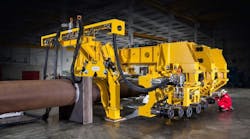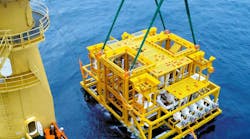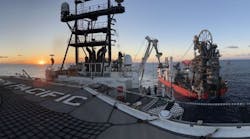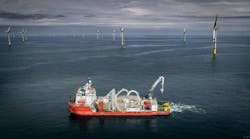Contractor repackaging to pursue
integrated projects
Jeremy Beckman
Editor, Europe
- Brown & Root holds the record for the design and fabrication of the world's deepest multi-well production manifold, deployed on Shell's Mensa Field in the Gulf of Mexico in 5,400 ft of water. [29,865 bytes]
- Through Rockwater in Aberdeen, Brown & Root managed engineering design, procurement, fabrication and installation of three pipeline bundles with towheads for Shell UK Expro's Gannet E and F field development. The longest bundle measured 7.1 km. [25,692 bytes]
Some firms are restricting their theater of operations to certain geographic locales or capabilities. At the other extreme is Brown & Root Energy Services, which says it wants to be all things to most deepwater people. Assuming the merger between parent company Halliburton and Dresser goes through, that prospect may prove a formality.
Dresser, if the US Federal Trade Commission does not object, will contribute two obvious assets in deepwater terms: Wellstream's flexibles and SubSea Offshore's ROVs. Although there is overlap between SubSea and Rockwater in flowline installations, the former is ahead in terms of ultra-remote intervention.
Reappraisal
The merger was presumably in Larry Farmer's (Group President of Brown & Root Energy Services) mind when he stated recently that his firm "had taken a hard look at its extensive subsea capabilities." Farmer questioned whether the organization was sufficiently focused to compete effectively in a global subsea market "undergoing a revolution in terms of its technology requirements."Most of the subsea engineering know-how was in place, but in danger of compartmentalizing itself. For example, the group's Greens Bayou yard in Texas was producing deepwater manifolds for projects on its doorstep, such as Shell's Mensa. Rockwater would offer controlled-depth-tow pipeline bundles out of Stavanger and Aberdeen, due to the North Sea's historic monopoly on such services. Yet all the while, potentially bigger markets for these products were emerging offshore Brazil and Angola.
Following a period of evaluation, Brown & Root drew up a core team from its various engineering sites, with orders to improve intra-group communication and transfer of subsea technology. According to the subsea business director, Chris Braithwaite, the plan is to build centers of excellence in all types of subsea work, with specialists able to mobilize to projects hosted from Singapore, Houston, or wherever.
So far, excellence centers have been established for six subsea technologies. Brown & Root in Stavanger spearheads engineering of deepwater risers and subsea processing. The UK fronts development of marine installation systems and pipeline bundles. Manifolds, templates, controls and long distance well tiebacks are the Houston office's domain.
"We feel that the role of subsea integrator is where we can add real value," says Braithwaite. Via its links with Halliburton, Brown & Root can handle turnkey subsea developments from reservoir appraisal, conceptual studies, well construction and facilities design through to installation and production operation. Halliburton, for example, can now factor in intelligent well completions through its joint venture with Aberdeen-based PES.
Over the years, numerous alliances have been formed - some more active currently than others - between, for instance, Rockwater and FMC and, for larger diameter pipelaying, Saipem (EMC). Pipeline design is often done co-operatively too, as in the case of Shell's Malampaya project off the Phillipines, where Brown & Root is currently working on front end and detailed engineering with J.P. Kenny.
Two projects
Two recent opportunities have arisen to demonstrate these subsea project skills:(1) The first was a nine-month EPCI subsea job awarded by the CACT consortium for a field 150 km off Hong Kong. It is also the first contract of its type in the Asia-Pacific region. Brown & Root's passage here was eased through EMC and Rockwater's recent track record off China.
Following engineering design from the Aberdeen offices, an umbilical, flexible flow and gas lift lines and risers are being fabricated for installation this summer between two subsea wells and an existing platform in 115 meters of water. Brown & Root is also responsible for the riser caisson construction and installation, with first oil due out in November.
(2) The other integration opportunity comes from Chevron, which included Brown & Root in its alliance of preferred contractors to develop deepwater Gulf of Mexico assets. The agreement is valid for the next decade, and may extend to other deepwater Chevron fields off West Africa.
For the project, Brown & Root is charged with project management and engineering, topsides fabrication and subsea engineering. Aker contributes Spar and TLP concepts, while Saipem provides pipeline solutions. In fact, all parties will be working on new deepwater technologies and solutions.
That arrangement contrasts with the UK North Sea, where most alliancing to date has been angled towards cost reduction. A more accurate parallel for the Chevron approach is Norway, says Braithwaite, where Statoil instigated frame agreements with suppliers for repeat orders on various subsea developments. However, views on this subject vary widely among the Gulf of Mexico majors and independents, he adds.
One-stop vendors
One-stop subsea shopping is not to everyone's liking. Some oil companies deliberately appoint teams of independent subsea vendors rather than have certain types of hardware or solutions foisted upon them. This is a charge often leveled at the heavyweight contractors - Braithwaite admits it is not the best tactic in some of the emerging markets."Brazil, for instance, is looking at new contracting arrangements and alternative solutions for designing and installing subsea developments. We ourselves are performing studies for foreign operators just moving into Brazil, like Shell.
There are some areas, though, where it is harder to mobilize comprehensive subsea resources, partly for reasons of logistics. Off West Africa, for instance, deepwater action is now strung out from Nigeria all the way down to Angola. In the Caspian, the scale of deepwater activity is hard to predict, with movement of advanced rigs hampered by the landlocked situation.
As for deepwater production in the Caspian, engineering groups may respond by co-sponsoring new local construction facilities, Braithwaite suggests. For more moderate depths, Brown & Root is currently at work on subsea studies for AIOC's GCA Phase 1 development, including infield pipelines.
Integrating subsea
Worldwide, Brown & Root employs 400 dedicated subsea engineers, and that does not include Rockwater personnel. But to outsiders, Rockwater is the group's subsea arm, and that was Rockwater's view too until the recent re-focus."Rockwater has had a strong image in the North Sea and South East Asia, but not in the Gulf of Mexico." That may change following plans to re-deploy two of the faster-moving installation vessels, Rockwater 1 and 2, to the Gulf, should demand warrant it.
A new addition to the fleet, the Toisa Perseus, will be available to any region, although its first job will be in the North Sea installing production manifolds for Esso Norge's Jotun development. The vessel, under construction at Dutch yard van der Giessen - de Noord, is designed for ultra-deepwater diverless operations, well intervention and workovers.
Numerous such vessels have been built for the North Sea of late, with subsea developments emerging everywhere.
One quandry is that increased subsea well numbers, in theory, generate demand for intervention, yet oil companies also want their wells designed to limit intervention. But as Braithwaite points out, operators are still on the learning curve in this regard - notably BP in its West of Shetland fields.
Toisa Perseus will be a 113-meter-long, 6,000 dwt, dynamically positioned vessel capable of housing a crew of over 100. Flexible pipelay equipment will be installed below decks to maximize working deck areas. The vessel will also have dual moonpools, an A-frame and extensive craneage.
Norway's temporary block on new oilfield developments, allied to the low oil price and tax uncertainties in the UK sector, may slow the subsea pace in the North Sea. Rockwater's work for Statoil's Gullfaks 2 project was one of the contracts deferred. If a serious slowdown sets in, Rockwater would re-deploy some vessels elsewhere.
Technology designed for the North Sea is already being transferred, such as controlled depth tow of flowline bundles. A first deepwater application has been identified in Brazil's Campos Basin. But instead of towing the bundle from the Wick base in northern Scotland, a new construction/launch site is under review closer to Brazil - possibly in Louisiana.
Pipelines, subsea
Rockwater has re-designed bundles for use in water depths down to 3,000 meters. The company outlines the differences compared with shallower water applications: "Essentially, the problem with bundles in depths below 1,000 meters relates to buoyancy.In a conventional bundle, the carrier pipe provides buoyancy during tow. To keep the weight down (and therefore buoyancy up) wall thickness of the carrier pipe is kept to a minimum. During tow, the external hydrostatic pressure acting on the pipe is countered by internal pressurization - clearly, a delicate balance with a relatively thin-walled pipe.
"As depth increases, the internal pressurization needed is higher to overcome the increased hydrostatic pressure. For safety reasons, the wall thickness needs to be increased and so buoyancy is compromised. Below 1,000 meters, the problems of balancing the various factors become too great to make the conventional concept fly."
Rockwater is also alert to subsea maintenance pressures. Although problems with Foinaven's leaking manifolds were widely reported, the speed of the re-installations was understated. Rockwater Regalia re-positioned each structure (following inspections and repairs) in 12 hours. Subsequently, Regalia's lift capacity was upgraded to 200 tons for 600-meter water operations. Last year, the contractor installed manifolds for Schiehallion, the second West of Shetland development.
Brown & Root's technical team in Houston also engineered a quick fix for a BP project in the Gulf of Mexico. Due to manufacturing problems with the Troika Field control umbilical, the November 1 first oil target last year did not appear feasible. However, Brown & Root devised a new plan which involved deploying a temporary riser/umbilical from the drilling rig to the subsea manifold, hydraulically powered via a microwave link. Early oil was achieved.
Riser studies
As an example of the improved intra-group co-operation on subsea R & D, Brown & Root and Rockwater are investigating a single hybrid riser system with Norsk Hydro for extended well tests in 900 meters of water in Mid-Norway's Voering Basin. The aim is to eliminate the need for testing through a drilling riser and to allow extended well tests to be performed from a dynamically positioned vessel.Brown & Root is also a member of the STRIDE JIP, (steel risers for deepwater environments.) Here the purpose is to develop steel catenary risers for harsh environment monohull floaters in water depths of 400-1,500 meters, with riser diameters of 10-30-in. Stage 1 design studies have been completed, with Stage 2 in progress to produce and prove components such as flexible joints. Stage 3 will involve full scale tests, with possible participation by Rockwater.
In addition to the world's deepest subsea manifold (Shell Mensa), Brown & Root also claims the record for the largest - a 1,000-ton structure for Texaco UK's Strathspey development, built in Nigg, Scotland. Now, says Braithwaite, the group is working on the next generation of templates and manifolds, with design based out of Houston. Ambitions include use of composites and system modularization. "But most important is the interface with flowlines, riser systems and wellheads."
Future targets for the group include subsea processing and seabed power distribution at greater depths. "Three thousand meters is emphatically not our limit," says Braithwaite.
Copyright 1998 Oil & Gas Journal. All Rights Reserved.




